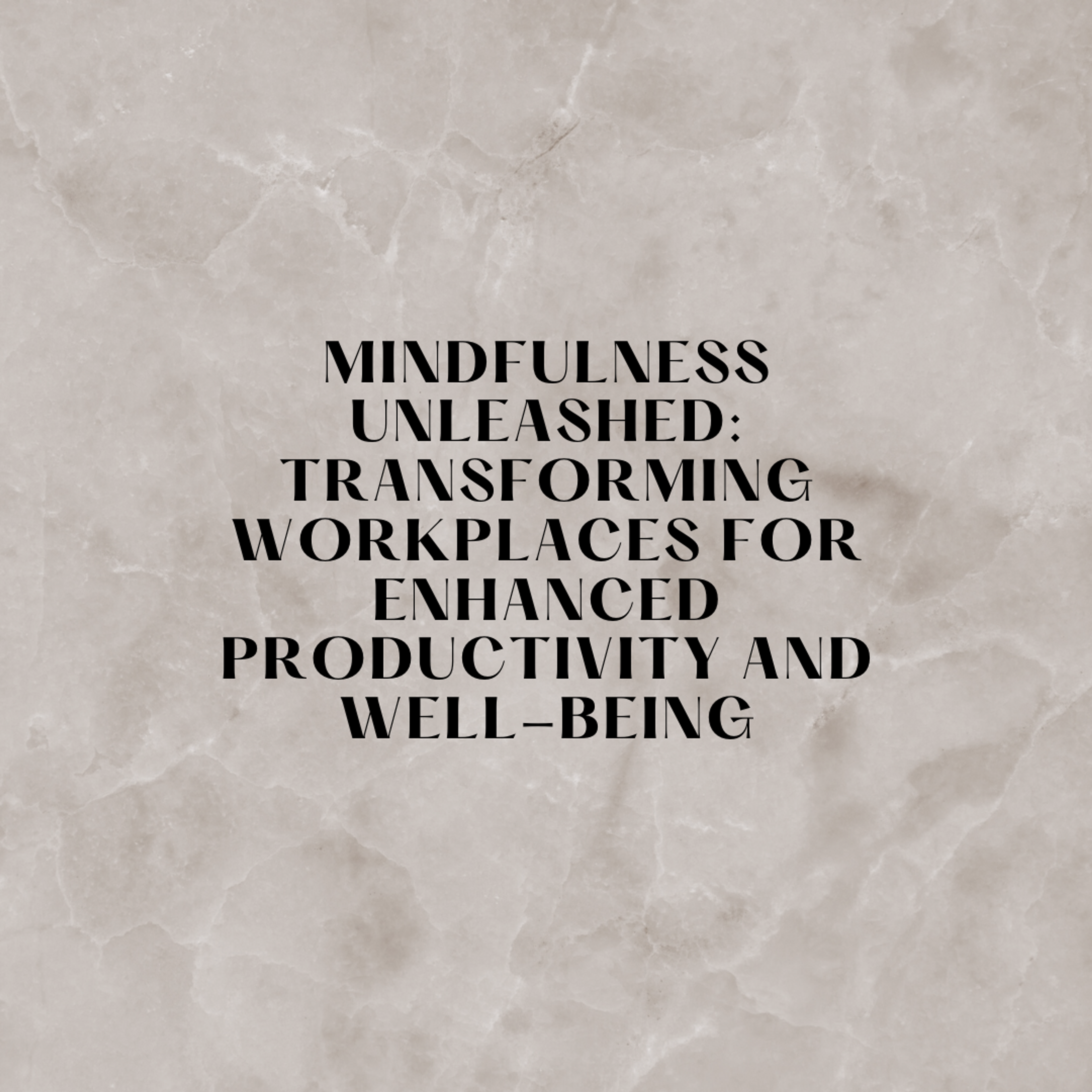Mindfulness Unleashed: Transforming Workplaces for Enhanced Productivity and Well-Being


In the hustle and bustle of the contemporary workplace, where demands and deadlines loom large, the quest for increased productivity and well-being has become more imperative than ever. Amidst the myriad of strategies, one timeless practice has emerged as a beacon of hope: mindfulness. Originating from ancient contemplative traditions rooted in Hinduism and Buddhism, mindfulness has evolved into a potent force capable of revolutionizing the dynamics of the modern professional setting. In this comprehensive exploration, we delve into the multifaceted impact of mindfulness on workplace productivity, dissecting how its incorporation can usher in a new era of heightened focus, engagement, and overall balance.
Mindfulness, at its core, involves being fully present and engaged in the current moment without judgment. It encourages individuals to bring their attention to their thoughts, feelings, and surroundings, fostering a heightened awareness of the present. This practice, often associated with meditation, has shown numerous benefits in various aspects of life, including stress reduction, improved focus, and enhanced emotional well-being.
The Workplace Productivity Connection:
1. Enhanced Focus and Concentration:
In the relentless rhythm of today's workplaces, where attention is constantly pulled in multiple directions, the ability to sustain focus has become a prized skill. At its core, mindfulness is about adopting a mindset that prioritizes the present moment. By training the mind to be fully engaged in the task at hand, individuals can declutter mental space, creating room for sustained focus. Conscious breathing, a fundamental aspect of mindfulness, serves as a practical tool to anchor attention. This intentional focus not only calms the mind but also sharpens the ability to direct attention purposefully.
In the face of information overload, mindfulness acts as a counterbalance. By encouraging a deliberate slowing down of thought processes, individuals can navigate tasks more effectively, mitigating the impact of the constant barrage of information. Mindful observation techniques, where individuals engage their senses fully in their work, further contribute to minimizing external distractions.
Scientific studies reveal the neurological underpinnings of mindfulness and focus. Regular mindfulness practice has been associated with positive changes in the brain's prefrontal cortex, the region responsible for attention and concentration. This suggests that mindfulness is not just a subjective experience but a tangible rewiring of the brain that supports improved focus over time.
Mindfulness extends beyond individual practices; it influences the way tasks are approached and transitions between them. Taking a moment to reset before moving to the next task prevents the carryover of distractions and mental residue, promoting a seamless shift and sustained focus. Organizations that cultivate a culture of mindfulness contribute to an environment where collective attention is valued, and colleagues respect each other's need for focused work time.
It's not just about doing more tasks; it's about doing them with greater precision and intentionality. By embracing the principles of mindfulness, employees can navigate the demands of their work with clarity and purpose, ultimately contributing to a more focused, engaged, and productive professional experience.
2. Stress Reduction and Resilience:
Embracing a mindful mindset becomes a shield against the detrimental effects of stress. By valuing the present moment and approaching stressors with a calm, non-judgmental awareness, individuals can navigate challenges with composure, fostering resilience in the face of professional uncertainties.
Central to mindfulness is meditation, a powerful tool for stress reduction. Mindfulness meditation involves focusing on the present moment without judgment, creating mental space to detach from stressors and approach them with a clear mind. This intentional pause serves as a reset button, instilling a sense of calm amidst the chaos of work life.
Mindfulness encourages the cultivation of emotional resilience by changing our relationship with stress. Awareness of emotional responses allows individuals to develop a non-reactive approach to challenges, responding thoughtfully rather than impulsively reacting under the influence of stress.
Conscious breathing, the basic of mindfulness, plays a pivotal role in stress management. Mindful breathing techniques act as an anchor in moments of stress, offering a practical and immediate way to center oneself. This intentional focus on the breath serves as a buffer against the physiological and psychological toll of stress.
Mindfulness not only contributes to stress reduction but also shapes a resilient workforce. Equipped with mindfulness tools, employees are better prepared to bounce back from setbacks, adapt to change, and maintain a sense of balance even in the face of adversity. This resilience becomes a valuable asset in navigating the uncertainties inherent in the professional world.
3. Improved Communication and Collaboration:
Adopting a mindful mindset in communication transforms the dynamics of interaction. Valuing the present moment and engaging with others with calm, non-judgmental awareness enhances the quality of communication, fostering a culture of attentive and purposeful interaction.
Mindfulness serves as a fertile ground for the cultivation of emotional intelligence, a cornerstone of effective collaboration. By changing our relationship with stress and emotions, individuals become more adept at navigating interpersonal dynamics, promoting understanding and collaboration even in challenging situations.
Mindful listening emerges as a potent tool in the realm of collaboration. Encouraging individuals to be fully present during conversations, actively listening without preconceived notions or distractions, fosters an environment where team members feel heard and valued, laying the groundwork for improved collaboration and synergy.
In conflict resolution, mindfulness becomes a guiding light. Approaching conflicts with a calm and open mindset enables individuals to navigate disagreements more constructively, leading to resolutions that benefit the entire team.
Just as a pebble creates ripples in a pond, mindfulness has a ripple effect in collaboration. When individuals bring a mindful approach to their interactions, it creates a positive atmosphere that extends to the entire team. This collective mindfulness fosters a culture where communication is clear, collaboration is seamless, and the collective intelligence of the team is harnessed for optimal results.
4. Increased Creativity and Innovation:
Embracing a mindful mindset becomes a gateway to enhanced creativity. By valuing the present moment and adopting a non-judgmental awareness, individuals create mental space for imaginative thinking, breaking free from conventional thought patterns and fostering a culture that encourages innovative ideas.
The practice of mindfulness encourages a liberated and non-judgmental mindset, stimulating creativity. By fostering an atmosphere where employees feel comfortable exploring new ideas without fear of criticism, organizations can tap into the innovative potential inherent in their workforce.
Mindfulness extends its influence to the very fabric of work processes. It prompts a revaluation of approaches, pushing individuals to consider multiple perspectives and think adaptively. This cognitive flexibility becomes a driving force behind creative problem-solving and the generation of groundbreaking ideas.
In the realm of mindfulness, the intentional focus on the present moment creates a space where inspiration can blossom. This heightened awareness allows individuals to connect seemingly unrelated ideas, leading to novel concepts and innovative solutions to challenges.
The role of mindfulness in shaping a culture of innovation extends beyond individual practices. Organizations that embrace mindfulness contribute to an environment where creativity is valued, and employees are empowered to think outside the box. This cultural shift becomes a breeding ground for innovation, where diverse ideas converge to propel the organization forward.
5. Better Decision-Making:
Central to effective decision-making is the cultivation of a conscious mindset. By embracing the present moment and fostering a calm, non-judgmental awareness, individuals open up mental space for nuanced reflection. This intentional focus facilitates a thoughtful evaluation of options, heightening sensitivity to the potential implications of each decision.
The undercurrent of conscious decision-making extends to the fabric of cognitive flexibility. Encouraging an openness to diverse perspectives and fostering adaptive thinking, this approach enables individuals to approach choices with a broader mindset, considering a spectrum of possibilities and potential outcomes.
In the conscious workplace, decision-making transforms into a holistic process that seamlessly integrates rational analysis with a profound awareness of the present. This fusion empowers individuals to make choices that not only align with strategic goals but also resonate with the core values and identity of the organization.
The deliberate emphasis on the present moment in conscious decision-making creates mental space for choices to unfold purposefully. This intentional approach minimizes hasty reactions and allows for a more thoughtful evaluation of alternatives, enhancing the overall quality of decisions.


